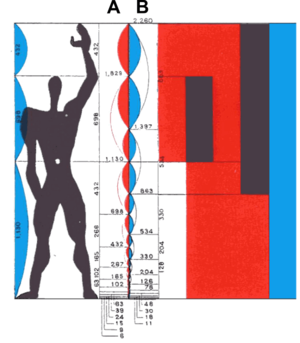Anthropometrics: Difference between revisions
From DT Online
mNo edit summary |
m (Added link) |
||
| Line 1: | Line 1: | ||
[[File:CorbusiersModulor.png|300px|right]] | [[File:CorbusiersModulor.png|300px|right|link=https://en.wikipedia.org/wiki/Modulor]] | ||
[https://en.wikipedia.org/wiki/Anthropometry#Ergonomics '''Anthropometrics'''] is the systematic collection and collation of measurements of the human body in order to establish [https://en.wikipedia.org/wiki/Average averages] and variations in height and shape for example. It is the branch of '''[[Ergonomics]]''' that deals with body shape and size. | [https://en.wikipedia.org/wiki/Anthropometry#Ergonomics '''Anthropometrics'''] is the systematic collection and collation of measurements of the human body in order to establish [https://en.wikipedia.org/wiki/Average averages] and variations in height and shape for example. It is the branch of '''[[Ergonomics]]''' that deals with body shape and size. | ||
Revision as of 19:41, 10 March 2016
Anthropometrics is the systematic collection and collation of measurements of the human body in order to establish averages and variations in height and shape for example. It is the branch of Ergonomics that deals with body shape and size.
People come in all shapes and sizes so you need to take these physical characteristics into account whenever you design anything that someone will use, from something as simple as a pencil to something as complex as a car.
The French Architect, Le Corbusier devised in the mid-20th century, a system of proportions and anthropometric measurements he called the Modulor to design products, furniture and even buildings, which not only look harmonious but also fit the human frame.
Activity: Try the activity described in the Ergonomics 4 Schools Learning Zone and compare some measurements with the table of 'averages' shown there.
